When I visited Minerve in the Languedoc-Roussillon last week we parked in the visitors car park outside the village which must be reached on foot. The car park was well designed and the light stream of visitors parked and followed a well-trodden path for their initial view of the beautiful village. Afterwards they followed the paths to the village pausing to take in the scenery and the atmosphere.
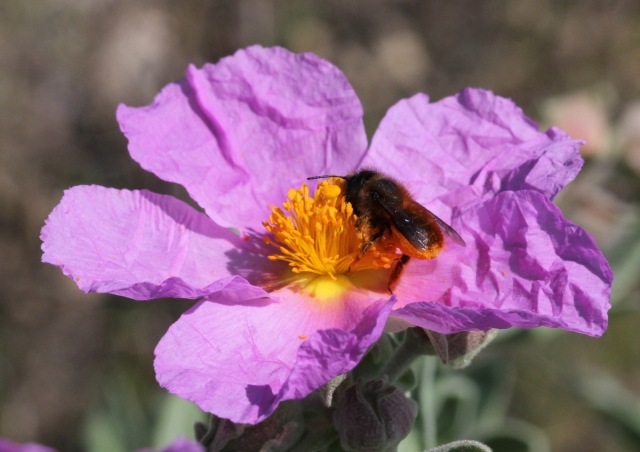
Alongside the path the wild flowers were growing in abundance and the wild bees were out in their numbers. I think this is a Cistus incanus which is a Mediterranean plant so I’m not sure whether it has arrived here by itself or it is indeed native to this area of southern France. It is so beautiful and provides the perfect foil for my bee which I think is the same Osmia cornuta which is nesting in my bee hotel in the garden.
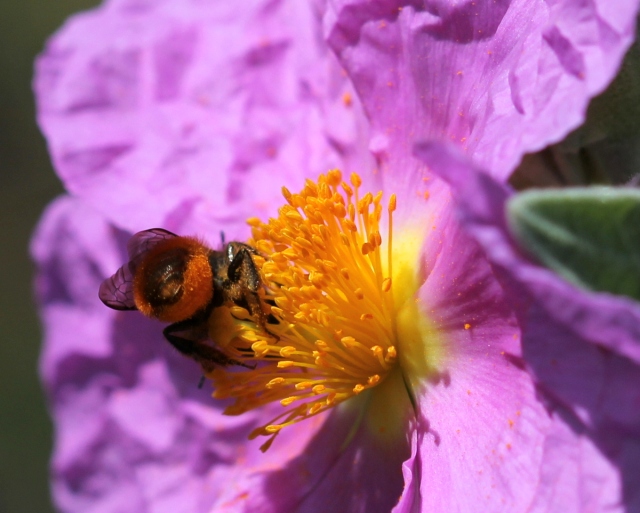
The Osmia do not collect pollen on their legs. The female Osmia have a brush of pollen-collecting hairs on the underside of their abdomen.
I was engrossed in my bees when I heard a voice from a party returning to the car park and explaining to a child that “The lady was taking pictures of the flowers”. The child was obviously more interested in what I was doing than admiring the view and I’m sure would have been fascinated with all the bees. It made me wonder how many people tread the well-trodden path and do not look any further.
After we left Minerve we followed a descending road but stopped at a marked view point. The view was truly remarkable but when we looked a little further we found an abundance of wild flowers.

The bees have plenty of forage at this time of year and were visiting the wild thyme.

Just off the path were yellow orchids, Ophrys lutea, I think.
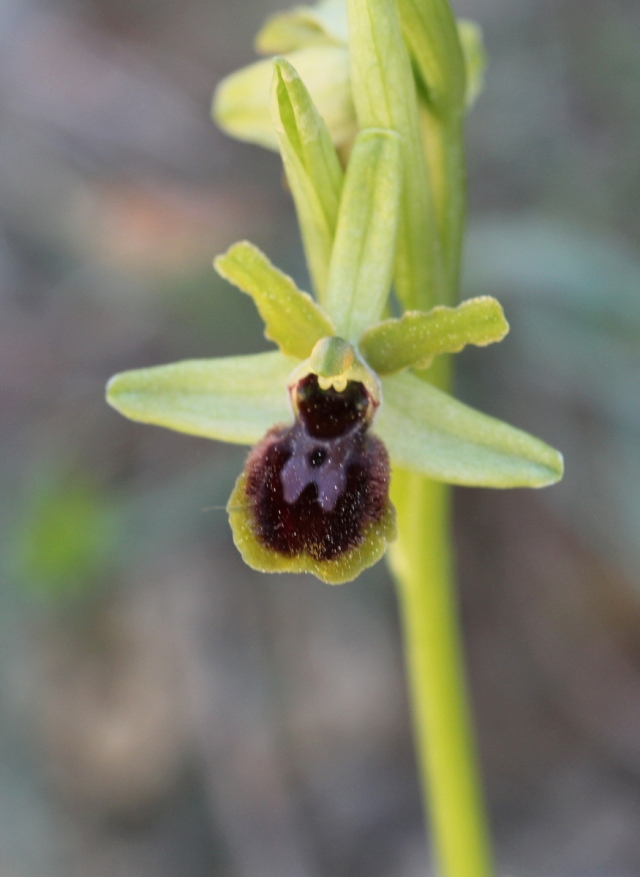
Close by was another which I think is the Spider orchid Ophrys aranifera, which doesn’t look to much like a spider to me.

I’m not even going to try naming this one as orchids are extremely difficult to identify. Lady Orchid, Orchis purpurea (Please see Susan’s comments beneath.)

This beauty was pushing up here and there, not as large or rambling as the sweet peas but just as attractive.
A peach tree had already set fruit testifying to the mild climate of the area. An almond tree was also in fruit with some of last years fruit still on the ground and edible.
Still, like good tourists we pressed on to our next stop and took in the views until the bees called again.

The cow parsley was attracting lots of bees and other insects.

This is a cuckoo bee, I cannot be more precise for the species. These bees do not build their own nests but lay their eggs in the nests of other bees. Their young will be nourished on the pollen and nectar set aside by other bees, quite like mining bees of the genus Andrena.
I was lured back to the straight and narrow by the promise of an ice cream in the village, so I left the bees and my photographing. It made me wonder though, how often we follow the well trodden paths and how much we miss in doing so.
Returning home on the motorway we stopped just outside Agen. The weather was fine and we really needed to stretch our legs. It was the usual petrol station/restaurant set-up but they seemed to have gone a little bit further than many in France and provided more places to sit and a pleasant play area for the children. Just across from the play area we found – yes, more orchids.
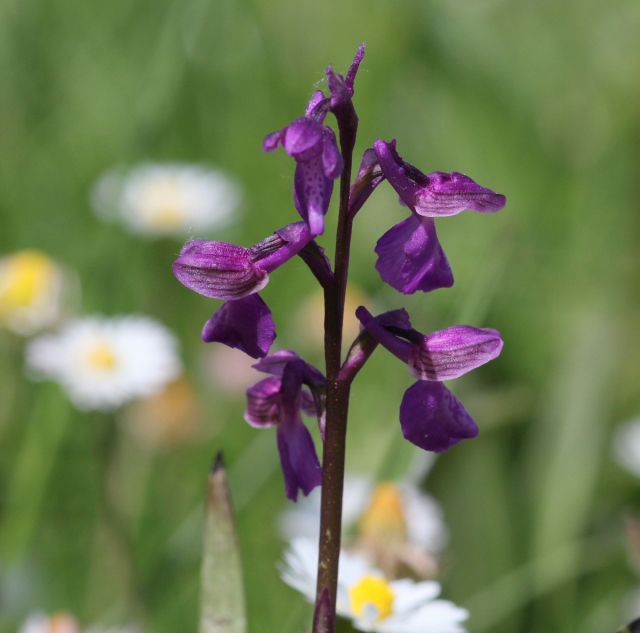
(See comments) Green-winged Orchid Anacamptis morio
And this beauty that is just starting to flower. (Tongued orchid, Serapias lingua – see comments)
We don’t have to wait for a signpost or a well trodden path to find something of beauty.

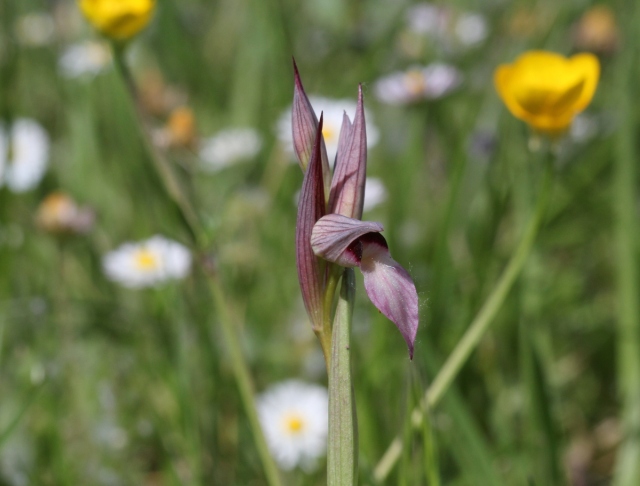
Nice trip! I am so impressed of you knowing every bee by name! 🙂
beautiful pictures.
LikeLike
Oh, I would love to know every bee by name. There are more than 200 different species of solitary bee in the UK and probably more in France. I am aiming to be able to identify 20 to start with. It is very difficult and frequently a photograph isn’t sufficient for a verification.
LikeLike
It is wonderful that there is still so much on a well trodden path. The plants and bees have made homes despite the foot traffic.
LikeLike
You don’t have to go to far to see a lot of beautiful things.
LikeLike
Indeed; sometimes at the back door is far enough.
LikeLike
The orchids are beautiful and the abundance and variety is amazing. I’ve hiked hundreds of miles over the past two years looking for them and have only seen two.
LikeLike
Perhaps they are more common in Europe.
LikeLike
New Hampshire has over 50 native orchids, but they’re very hard to find.
LikeLike
Perhaps its the old story, you find things when you are not looking for them. I was looking at the bees and I found orchids! Some orchids can be very small and insignificant until you get up close.
LikeLike
A real eye-opener – I know the areas you mention, and have NEVER noticed such beautiful orchids – I will have to be more vigilant – thanks so much for bringing these to my attention.
LikeLike
May seems to be a very good month to see them in France. Now you know, you will probably see them, there are lots of different ones.
LikeLike
Amazing photos – especially the bee on the cow parsley.
LikeLike
Mmm. you liked the cute honey bee best 🙂
LikeLike
Gorgeous photos! Are these native orchids, or have they been planted here? It’s such an amazing diversity of types. And your photos are wonderful.
LikeLike
They are native. On holiday in the Dordogne one year I found 12 different varieties of wild orchids quite close together in the woodland gardens of the property.
LikeLike
Wonderful images Amelia; my husband walked with a friend on Wednesday (a holiday here) and he saw masses of wild flowers too, including orchids; sadly he’s not so avid a photographer as me so I only have his description but no photos! I do agree with you that many people miss so much because they simply don’t look. Christina
LikeLike
I must admit I used to walk with my eyes set on the distance but I try to be more attentive now.
LikeLike
Your orchids are: Ophrys lutea (I am green with envy); Early Spider Orchid O. sphegodes (syn O. aranifera) or Small Spider Orchid O. araneola (I can’t tell which from this photo — they look like spiders because of the two beady little eyes in the throat); Lady Orchid Orchis purpurea; Green-winged Orchid Anacamptis morio (could be subsp picta); Tongue Orchid Serapias lingua.
Your Cow Parsley looks like Wild Parsnip Pastinaca sativa to me (just as popular with insects). The Red Vetchling L. cicera is lovely. We don’t get that here at all.
Great pics of the bees doing their thing — really good behavioural shots. I have a suspicion the one on the Cistus is a Megachile sp, btw.
It sounds like a great visit, and a good time had by all.
With regard to the little boy being interested in what you were doing, my guess is that photographing flowers is OK, but if you told his mother you were photographing insects she would have been completely nonplussed. My sister and I had two women ask us what we were photographing in a nature reserve near Alice Springs once. When we said ‘that dragonfly over there’ they grunted and went on their way without another word or glancing in the dragonfly’s direction! I have no idea what subject would have gained their attention. Good thing they hadn’t caught me photographing kangaroo poo 5 minutes earlier!
LikeLike
Thanks for all the IDs, Susan. I still don’t get the spider thing but at least now I know what I’m supposed to see. I think you are right about the adults: photographing flowers is O.K. but people think bees are scary and dangerous. I’m sure the child would have had more fun helping me find bees than looking at scenery.
LikeLike
You always remind me to look.
LikeLike
Gosh you live were orchids grow! Cool!
Linda
http://coloradofarmlife.wordpress.com
http://deltacountyhistoricalsociety.wordpress.com
LikeLike
They are not too uncommon in Europe. I have two different types that have appeared in the garden by themselves. We live near woods and the ground has never been farmed.
LikeLike
This must be paradise, a village were you have to park outside. And all the lovely, wild orchids, my favorites! This must be the right time to visit this part of the world. I don’t know them, but the “another yellow orchid resembles one of our, our only Ophrys, the Ophrys insectifera. By the way, not a single flower yet in Norway…
LikeLike
May, June is a great time to visit France but it can be a bit quiet as the French have a tendance to go on holiday only during July and August.
LikeLike
Beautiful photos. What a lovely walk! I love seeing all the wild flowers at the roadsides in spring and early summer.
LikeLike
For me it is the best time of the year.
LikeLike
As a hardened birdwatcher, with an interest in insects, I only started looking seriously at flowers after getting my ankle shattered in a forestry accident…
I was told that I must not walk on uneven ground…
“S#D THAT!!” thought I….
and, using a stick, started walking very slowly in the wild…
watching very carefully where I put my feet…
and began to notice very small flowers at my feet…
Milkweeds, small Forget-me-Nots and tiny Geranium sp. to begin with….
I’d always been aware of the beauty of some, more majestic flowers…
but the tiny beauty of these grabbed me…
and have never let go!!
Great pix as usual… and interesting information about the Osmias…
LikeLike
I think I notice things more now that I am on the look out for bees. Anything that makes us notice more can’t be a bad thing.
LikeLike
Lovely post and absolutely stunning photos Amelia! What beautiful orchids.
LikeLike
Actually I was looking for bees 🙂
LikeLike
Your photographs of the honey bee are excellent. What makes you such an avid bee watcher?
Shakti
LikeLike
It all started when an Anthophora plumipes stared at me out of a hole in the house wall. Then I saw the mining bees digging their nests in the soil. If you are quiet they let you watch them, most other creatures run away.
LikeLike
Very nice series . . . makes me itchy for the start of our flowering season.
LikeLike
I’m sure it won’t be long now and spring is such a great time for flowers.
LikeLike
Great pics, love the bees…
LikeLike
Thank you, I’m really enjoying trying to spot all the solitary bees now but I haven’t forgotten my bumbles.
LikeLike